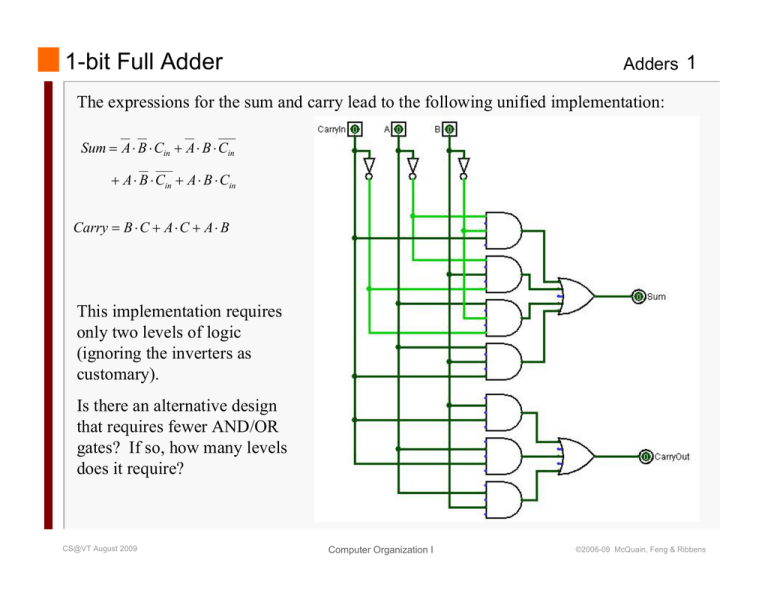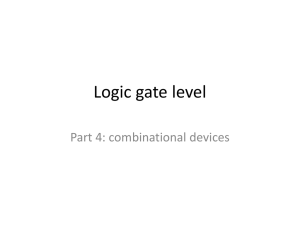1-bit Full Adder
advertisement

1-bit Full Adder Adders 1 The expressions for the sum and carry lead to the following unified implementation: Sum A B Cin A B Cin A B Cin A B Cin Carry B C A C A B This implementation requires only two levels of logic (ignoring the inverters as customary). Is there an alternative design that requires fewer AND/OR gates? If so, how many levels does it require? CS@VT August 2009 Computer Organization I ©2006-09 McQuain, Feng & Ribbens LogiSim Implementation Adders 2 The previous circuit is easily implemented in LogiSim. CS@VT August 2009 Computer Organization I ©2006-09 McQuain, Feng & Ribbens LogiSim Analysis Tool Adders 3 The Project menu contains an option to analyze the circuit. You may find these useful in verifying the correctness of a circuit. CS@VT August 2009 Computer Organization I ©2006-09 McQuain, Feng & Ribbens 1-bit Full Adder as a Module Adders 4 When building more complex circuits, it is useful to consider sub-circuits as individual, "black-box" modules. For example: Sum A B Cin A B Cin A B Cin A B Cin Carry B C A C A B CS@VT August 2009 Computer Organization I ©2006-09 McQuain, Feng & Ribbens Chaining an 8-bit Adder Adders 5 An 8-bit adder build by chaining 1-bit adders: This has one serious shortcoming. The carry bits must ripple from top to bottom, creating a lag before the result will be obtained for the final sum bit and carry. CS@VT August 2009 Computer Organization I ©2006-09 McQuain, Feng & Ribbens Computing the Carry Bits Adders 6 Any Boolean function can be computed using two levels of logic gates (not counting inverters)… why? Therefore, it should be possible to compute all of the carry bits needed by the preceding 8bit adder using only two levels of logic gates, and that should provide a way to speed up the computation of the final result… Let's consider the problem of adding two 8-bit operands, A and B, and label the bits of each as: a7 a6 a5 a4 a3 a2 a1a0 b7b6b5b4b3b2b1b0 Similarly, label the relevant carry bits as: c8c7 c6 c5c4 c3c2 c1c0 Normally 0! And finally, label the sum bits as: s7 s6 s5 s4 s3 s2 s1s0 CS@VT August 2009 Computer Organization I ©2006-09 McQuain, Feng & Ribbens Computing the Carry Bits Adders 7 We can derive some interesting (Boolean) results for the carry bits: c1 b0 c0 a0 c0 a0 b0 c2 b1 c1 a1 c1 a1 b1 But… this shows c2 as dependent on first knowing c1… which is the ripple carry logic. However, if we substitute we can show: c2 b1 c1 a1 c1 a1 b1 b1 (b0 c0 a0 c0 a0 b0 ) a1 (b0 c0 a0 c0 a0 b0 ) a1 b1 a1 b0 c0 a1 a0 c0 a1 a0 b0 b1 b0 c0 b1 a0 c0 b1 a0 b0 a1 b1 And that gives us c2 in two levels of logic gates… but imagine how complex the formulas would be for the higher-order carry bits… CS@VT August 2009 Computer Organization I ©2006-09 McQuain, Feng & Ribbens Abstraction Adders 8 Take the original (generalized) carry equation and factor it: ci 1 bi ci ai ci ai bi ai bi (ai bi ) ci Then, if we rewrite the formula for c2, we have: c2 a1 b1 (a1 b1 ) (a0 b0 (a0 b0 ) c0 ) g1 p1 ( g 0 p0 c0 ) where: g1 a1 b1 and p1 a1 b1 We call the latter terms the generate and propagate factors. CS@VT August 2009 Computer Organization I ©2006-09 McQuain, Feng & Ribbens Generate and Propagate Adders 9 We can then express the general carry bit formula: ci 1 gi pi ci The formula indicates that if gi = 1 then the adder generates a carry-out no matter what the value of the carry-in ci might be. Moreover, if pi = 1, then if there is a carry-in, the adder propagates a carry-out to the next position no matter what the generate bit gi might be. So we can show that: c1 g 0 p0 c0 c2 g1 p1 c1 g1 p1 g 0 p1 p0 c0 c3 g 2 p2 c2 g 2 p2 g1 p2 p1 g 0 p2 p1 p0 c0 c4 g3 p3 c3 g3 p3 g 2 p3 p2 g1 p3 p2 p1 g 0 p3 p2 p1 p0 c0 Now, note that we can calculate all the g's and p's in one level of logic from the bits of the two operands, so we can calculate these four carry bits in just three levels of logic. But… this will still get very complex if we try to find higher-order carry bits… CS@VT August 2009 Computer Organization I ©2006-09 McQuain, Feng & Ribbens 4-bit Fast-Carry Adder Adders 10 We can build a 4-bit adder using the fast-carry logic shown on the previous slide: Computes the four carry bits in three levels of logic… …carry bits are then fed to the four adders… …which then compute the sum bits CS@VT August 2009 Computer Organization I ©2006-09 McQuain, Feng & Ribbens A Higher-level Abstraction Adders 11 The formulas grow too complex to make this approach ideal for building a practical (wider) adder… however, we can consider cascading four of the 4-bit fast-carry adders to implement a 16-bit adder. To do this, we must consider the carry bits that must be generated for each of the 4-bit adders. We can adapt the approach used above to create a higher-level fast-carry logic unit to generate those carry bits quickly as well. See Appendix C.6 in P&H for the details. CS@VT August 2009 Computer Organization I ©2006-09 McQuain, Feng & Ribbens

